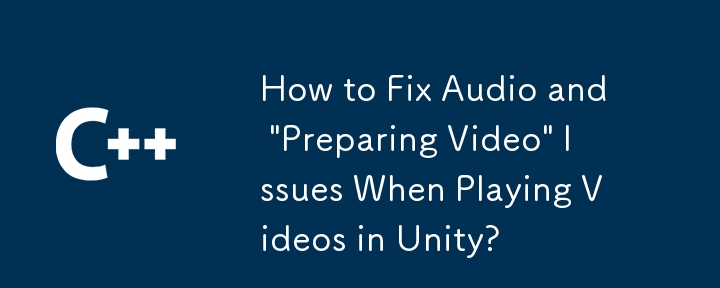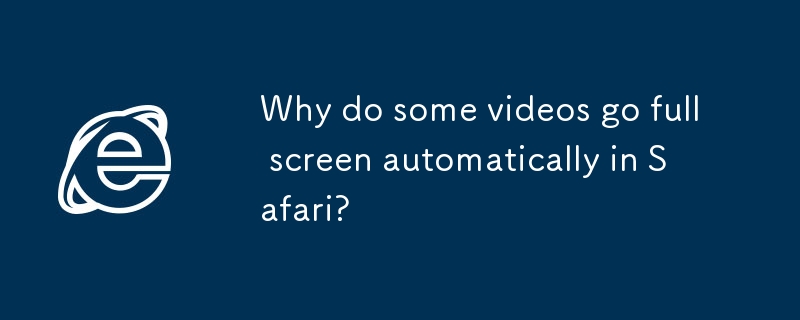Found a total of 10000 related content

10 Best jQuery and HTML5 Media Players
Article Introduction:Ten best jQuery and HTML5 video players tutorials
In the past, Flash videos were used on websites because Flash was almost the only option to play videos. But now everyone wants video playback support to be broader, with multiple audio and video formats, playlists, adjustable controls, automatic aspect ratio video and more… All of these features can be achieved by using jQuery plug-in and HTML5, and you can use audio and video in a simple way. Check out the ten best jQuery and HTML5 player tutorials we have compiled below! enjoy! Related articles:
10 Crazy HTML5 and JS Experiments Showcase
jQuery and the new HTML5 key points
jQuery
2025-02-27
comment 0
561

Troubleshooting HTML5 Video Autoplay Restrictions
Article Introduction:To solve the problem of restricting HTML5 video automatic playback, the first thing to do is to clarify the answer: it can be effectively dealt with by mute automatic playback, user interaction playback, checking video format and path, and paying attention to browser policy updates. Specifically: 1. Add muted attributes to the video to achieve muted automatic playback; 2. Call the play() method after the user clicks on the page element to restore the sound or start the playback, which is especially suitable for mobile terminals; 3. Check the video format compatibility, path correctness and server configuration to ensure that the video can load normally; 4. Pay attention to changes in browser policies and capture playback errors through JavaScript to adjust the strategy in time, thereby improving the success rate of automatic playback.
2025-07-12
comment 0
275


Extending OctoberCMS - Building a Soft-Delete Plugin
Article Introduction:OctoberCMS: In-depth exploration of plug-in expansion and practical combat of soft delete plug-in
Developers generally prefer easy-to-use and scalable CMS. OctoberCMS adheres to the concept of simplicity first, bringing a pleasant experience to developers and users. This article demonstrates some of the extensible features of OctoberCMS and extends the functionality of another plug-in with a simple plug-in.
Key Points
OctoberCMS provides a simple and easy-to-use CMS while allowing extensions through plug-ins. This scalability is reflected in the extent to which developers can penetrate the internal mechanisms of CMS, including modifying the functions of other developers plug-ins.
The Rainlab Blog plugin allows articles to be created and assigned to different categories.
2025-02-10
comment 0
1210

HTML Audio and Video: The Complete Tutorial
Article Introduction:Using audio and video in web pages is important because they expand expressiveness and enhance user experience. 1. Audio tags are used for background music, podcasts, etc., and must specify the source, automatic playback and controls. 2. Video tags are used for product introduction, educational courses, etc., and must specify the source, width and height, automatic playback and loop playback. 3. Optimization strategies include compressing files, using WebM format, avoiding automatic playback, and providing clear controls. 4. Use elements to add subtitles to improve accessibility. 5. Best practices include responsive design and SEO optimization.
2025-06-26
comment 0
243

How to stream video using HTML5?
Article Introduction:To use HTML5 to stream videos in web pages, you can achieve the following steps: 1. Use tags to embed the video source, such as adding multiple tags to support multiple formats; 2. Set autoplay, muted and loop properties to achieve automatic playback and loop playback; 3. Control the playback behavior through JavaScript, such as using document.querySelector('video').play() to trigger playback; 4. Customize styles and controls, hide native control bars and use CSS to beautify the video area; 5. It is recommended to use MP4 format during deployment and consider streaming services to improve the loading experience.
2025-07-09
comment 0
520

What is the Video API, and how do I use it to control video playback using JavaScript?
Article Introduction:How to use JavaScript to control web video playback? The answer is through HTML5 elements and their related methods and properties. The specific steps are as follows: 1. Basic settings: Use tags with ids and select multiple video sources to enhance compatibility; 2. Control playback: Call play(), pause() through JavaScript, set currentTime, volume and muted properties to achieve playback control; 3. Handle events: listen to play, pause, ended and other events to respond to changes in video status; 4. Custom controls: build UI elements such as play/pause buttons, and handle loading status and barrier-free support; 5. Pay attention to browser restrictions, such as muted automatic playback strategy
2025-06-22
comment 0
563


How to make a video play inline on mobile devices?
Article Introduction:The key to making video inline playback on the mobile terminal is to set the playsinline and webkit-playsinline properties, cooperate with the mute automatic playback strategy, and handle compatibility issues between iOSSafari and shell browsers. 1. Use the playsinline and webkit-playsinline properties to ensure that the video can be played inline in the page; 2. Set muted and autoplay to meet the automatic playback strategy; 3. For iOSSafari limitations, WeChat JSSDK can be introduced, third-party videos can be embedded with iframes or canvas simulate playback; 4. Test to ensure compatibility in different devices and browsers.
2025-06-29
comment 0
767

How to add video to a webpage using the tag?
Article Introduction:Use tags to embed videos directly in web pages without third-party plug-ins; 2. It is recommended to use elements to provide various formats such as mp4, webm, ogg, etc. to ensure browser compatibility; 3. Add controls, muted, loop, preload, poster and other attributes to improve the playback experience; 4. Automatic playback needs to be matched with muted attributes to avoid being blocked by the browser; 5. Borders, rounded corners, shadows and responsive sizes can be set through CSS to optimize the video style; 6. Provide fallback text in the tag to prompt browsers that do not support video. Use these methods correctly to achieve native, compatible and beautiful web video embedding.
2025-07-30
comment 0
435

python opencv video capture example
Article Introduction:Using OpenCV can realize camera video capture, and read the default camera and display the screen in real time by creating VideoCapture objects; 2. You can set resolution, frame rate and other parameters to optimize video quality; 3. You can save the frames captured by the camera as a video file, and you need to ensure that the encoding format, resolution and frame size of VideoWriter matches the frame size; 4. Support reading local video files such as mp4 and avi formats and playback; 5. Notes include correctly setting waitKey to control playback speed, device number selection, system permissions and driver support issues. This example fully covers the core functions of video capture, display, save and playback in OpenCV, and expands face recognition, motion detection and other applications for subsequent expansion.
2025-07-27
comment 0
175

How do you embed video and audio in an HTML5 document?
Article Introduction:Use and tags to embed video and audio in HTML5 respectively; 2. To ensure compatibility, video should be provided with MP4 and WebM formats, and audio should be provided with MP3 and Ogg formats; 3. Add controls attributes to display playback controls, and use source tags to specify multiple source files; 4. Avoid unsilent automatic playback because it is often blocked by the browser; 5. Add subtitles through the track tag to improve accessibility; 6. Provide alternate text in the tag to support older browsers; and ultimately achieve compatible playback across modern browsers.
2025-08-02
comment 0
632


How to embed a responsive video in Bootstrap?
Article Introduction:To embed responsive video, Bootstrap5 uses .ratio class and sets --bs-aspect-ratio variable, Bootstrap4 uses .embed-responsive and its scale classes; 1. In Bootstrap5, use wrapping iframes; 2. In Bootstrap4, use and add embed-responsive-item class to iframes; 3. Always use embedded links (such as youtube.com/embed/...) instead of normal playback links; 4. Add allowfullscreen attribute to support full-screen playback; 5. The video will automatically adapt to container width and remain
2025-08-02
comment 0
604

HTML `video` Autoplay and Muted Attributes
Article Introduction:In web development, automatic video playback requires both autoplay and muted properties. Because modern browsers prevent audio video from automatically playing by default, automatic playback is more likely to be allowed only in a silent state. Common writing methods include: 1. No need to pay attention to the attribute order; 2. No need to assign values to muted; 3. Dynamic unmute may be intercepted and must be operated after user interaction. Development suggestions include prioritizing mute automatic playback, providing an unmute button, monitoring user interaction before unmute, and paying attention to browser compatibility differences.
2025-07-18
comment 0
740

What attributes are used to control display and playback for the html video element?
Article Introduction:To control the display and playback of HTML elements, a series of attributes are required. 1. Basic playback control: src specifies the video URL, controls adds default controls, autoplay implements automatic playback (usually needs to be combined with muted), loop playback, muted default muted; 2. Display and layout: width/height sets the size, poster defines the preview diagram, preload controls the loading strategy; 3. Advanced behavior and compatibility: playsinline allows inline playback in iOS, and tags provide multi-format support to ensure cross-browser compatibility.
2025-07-27
comment 0
403

how to change the playback resolution in Premiere Pro
Article Introduction:There are three ways to adjust the playback resolution in PremierePro. First, modify the default playback resolution through "Sequence Settings". After opening the project, click "Sequence" > "Sequence Settings" in the top menu, and select the required resolution such as 1/2, 1/4 or custom ratio to save it; second, temporarily adjust the playback resolution, you can click the setting icon in the lower right corner of the program monitor and select "Scaling Scale" or "Resolution" to achieve it; third, adjust the global playback performance settings, and configure the proxy format, hardware accelerated decoding and playback performance options through "File" > "Project Settings" > "Media Collection and Cache" to optimize the smoothness of high-resolution video playback.
2025-07-25
comment 0
200

Why do some videos go full screen automatically in Safari?
Article Introduction:Safari sometimes forces video full screen playback due to website settings, automatic playback behavior and its own restrictions, mainly on iOS devices. 1. Safari's automatic playback strategy forces full screen: If videos on iOS are automatically played with sound, full screen will often be triggered. Apple's move is to prevent noise and save resources; users can mute the screen in advance, quickly click on the screen, or use websites that do not force automatic playback to avoid it. 2. Video tag configuration results in full screen: If the website does not correctly set the playsinline attribute, Safari will default to full screen; developers should add this attribute and test it, and users can feedback questions or use another browser instead. 3. The difference between iOS version and browser affects playback behavior: iOS10 supports inline playback but depends on the website correctly
2025-07-19
comment 0
254

How to manage accessibility settings in Edge
Article Introduction:The accessibility settings of the Edge browser are comprehensive and practical, suitable for users with different needs. 1. Adjust the font size and page scaling: You can adjust it in Settings → Accessibility → Visual, or use the shortcut Ctrl /-/0 for temporary zooming to facilitate reading long articles; 2. Use high contrast mode: Enable high contrast rendering under the same path to improve visibility but may affect some web page typesetting; 3. Screen reader support: Ensure that the "make web content easier to access by assistive technology" option is enabled, Edge deeply integrates the accessibility framework, and is adapted to screen reading software such as NVDA or JAWS; 4. Turn off automatic video playback: Disable automatic playback in media and playback settings to reduce interference and set exceptions for specific websites.
2025-07-16
comment 0
662


















